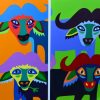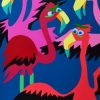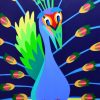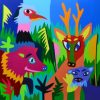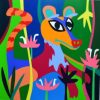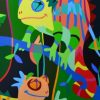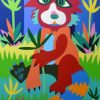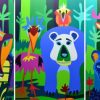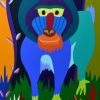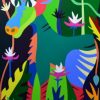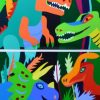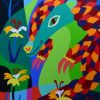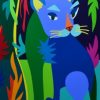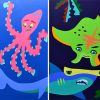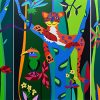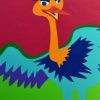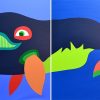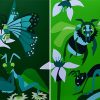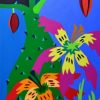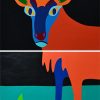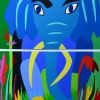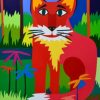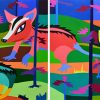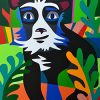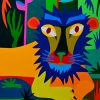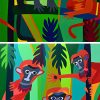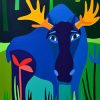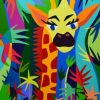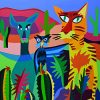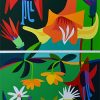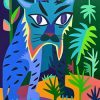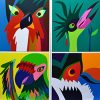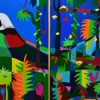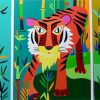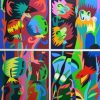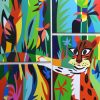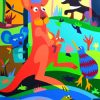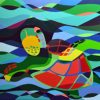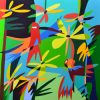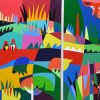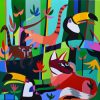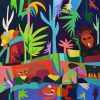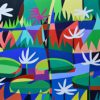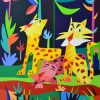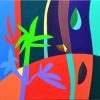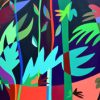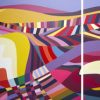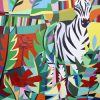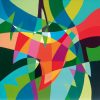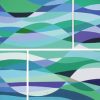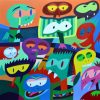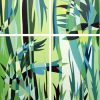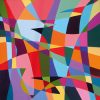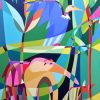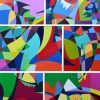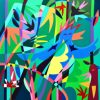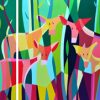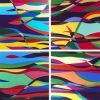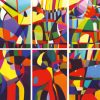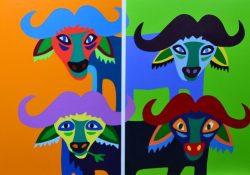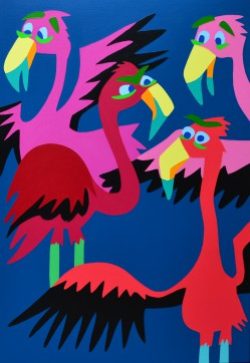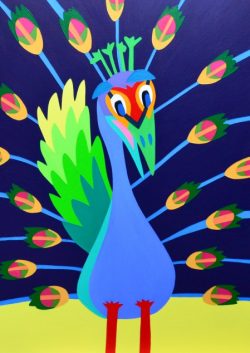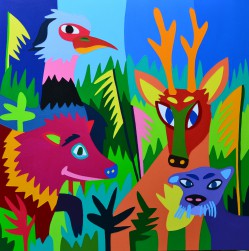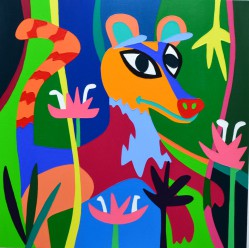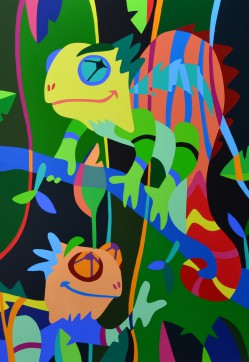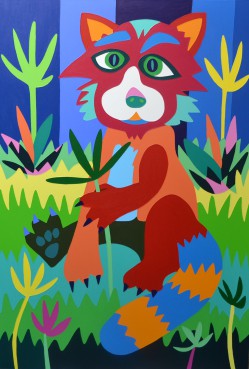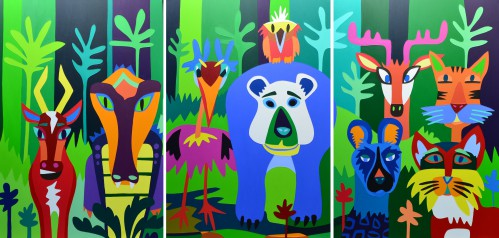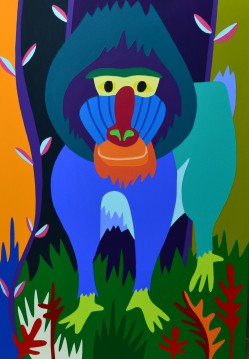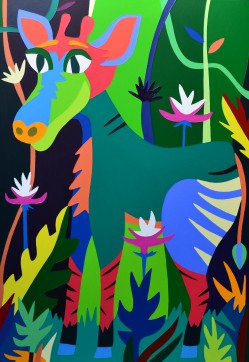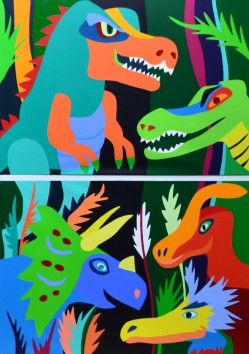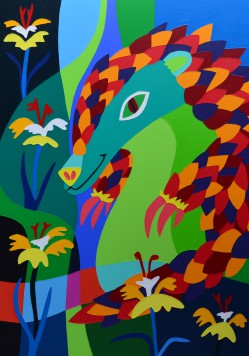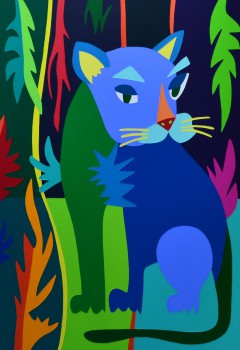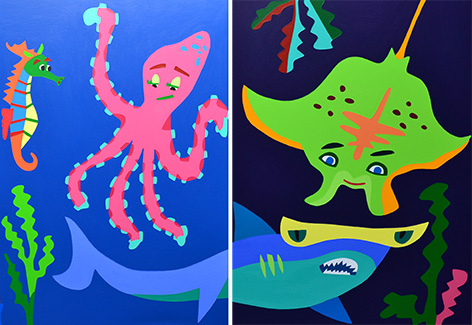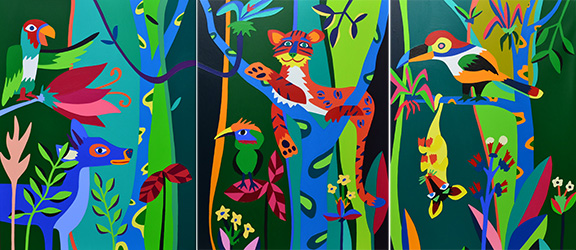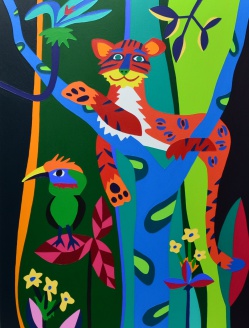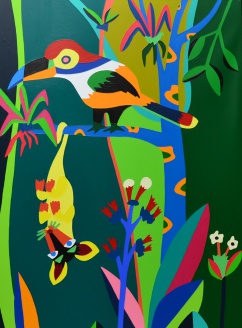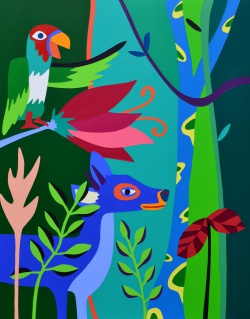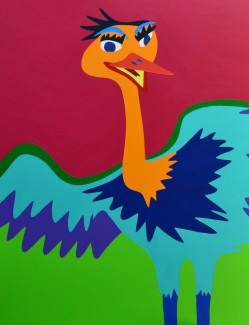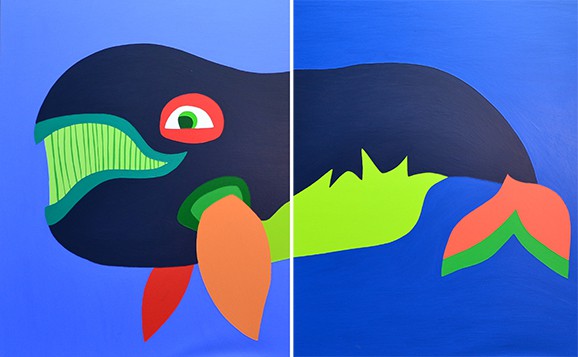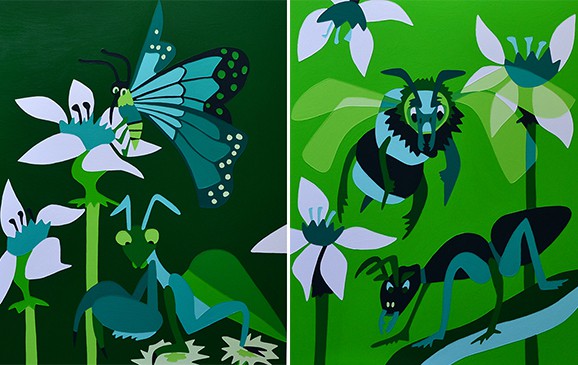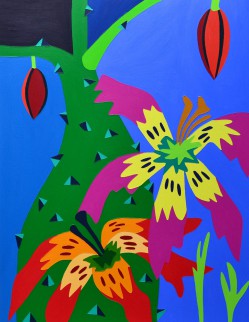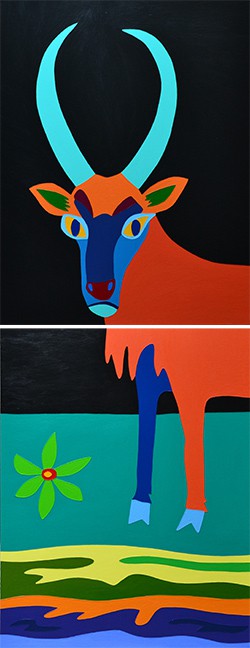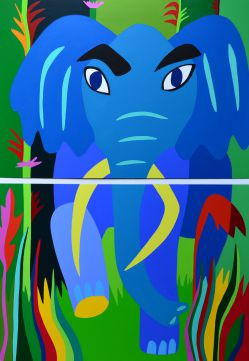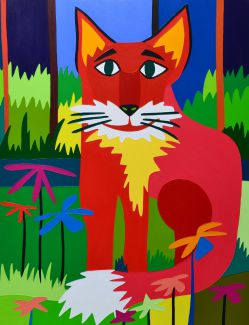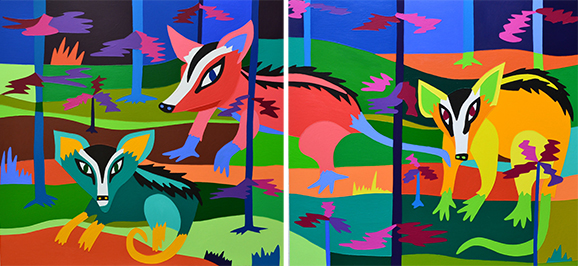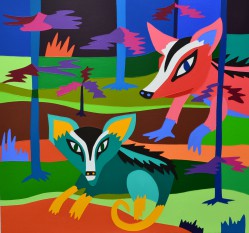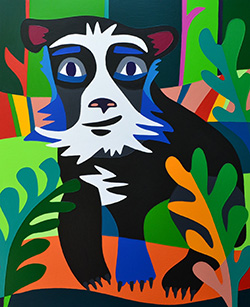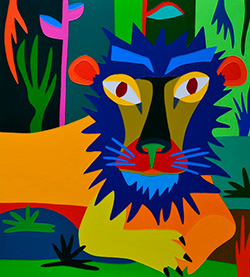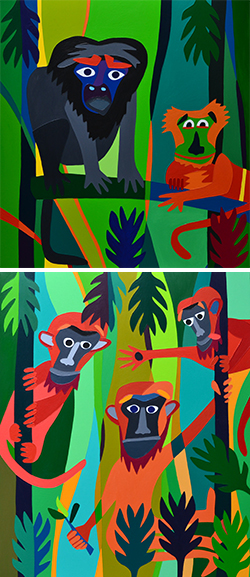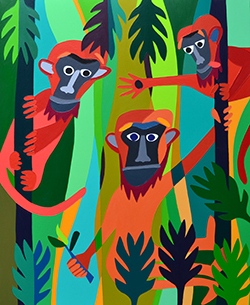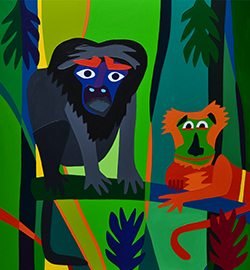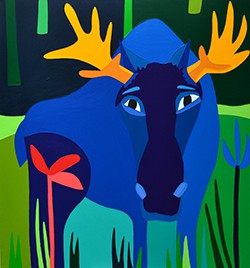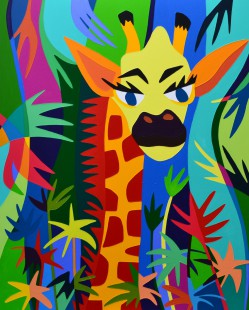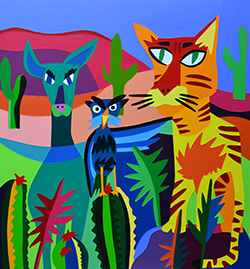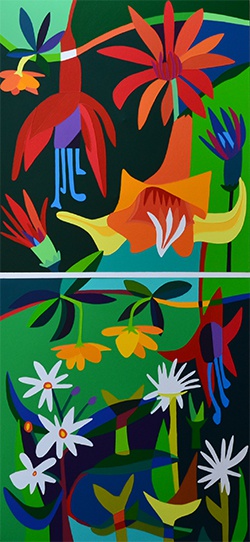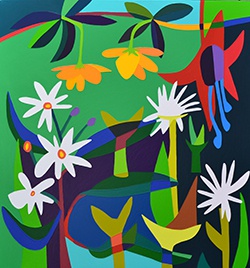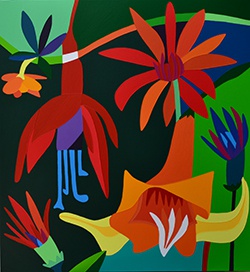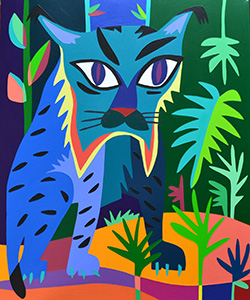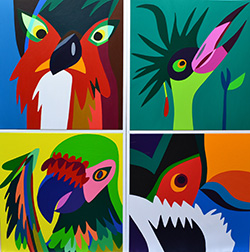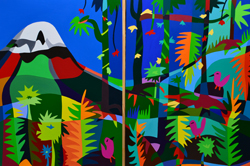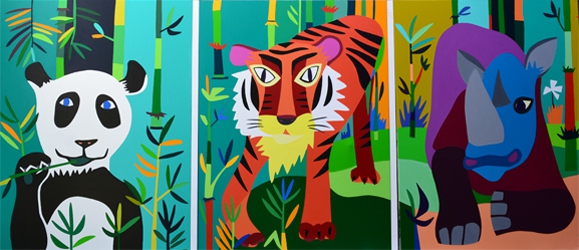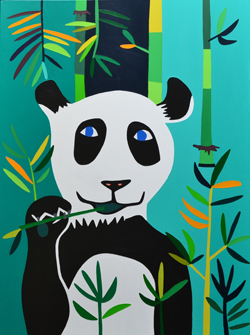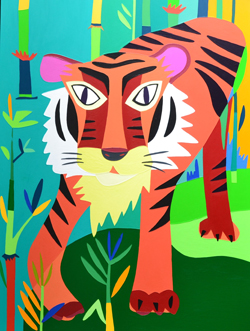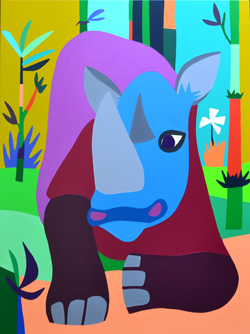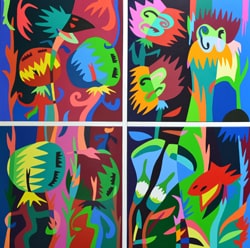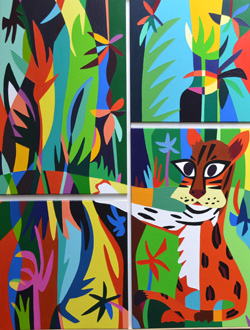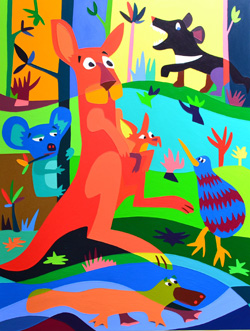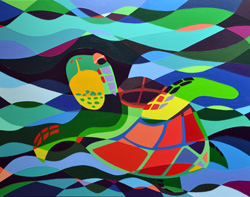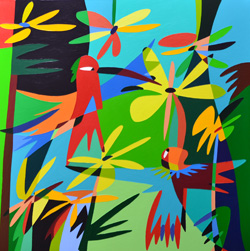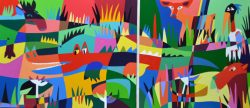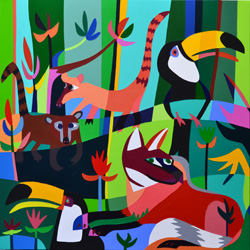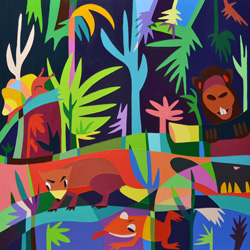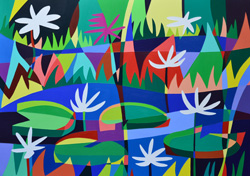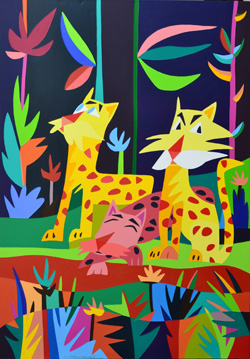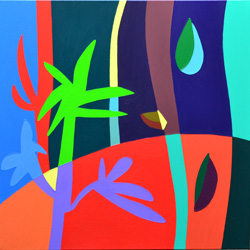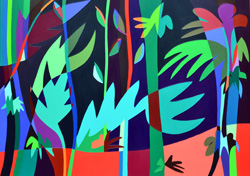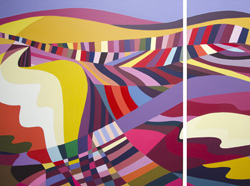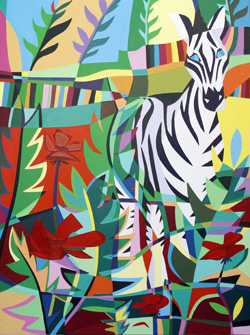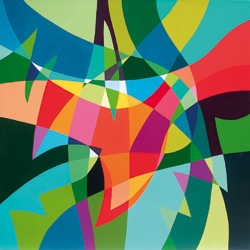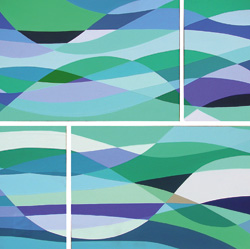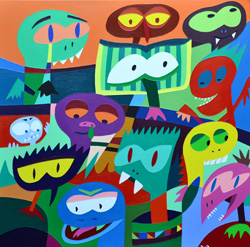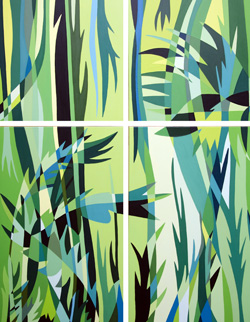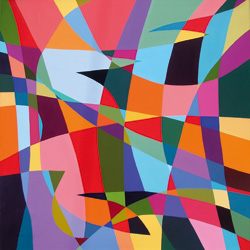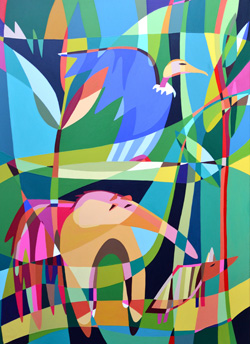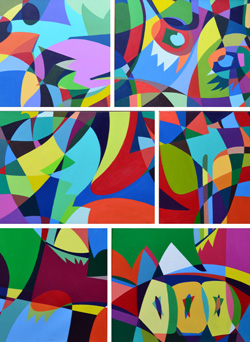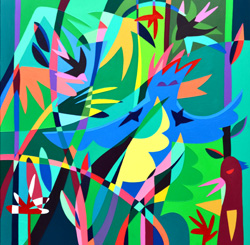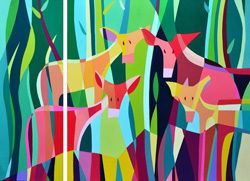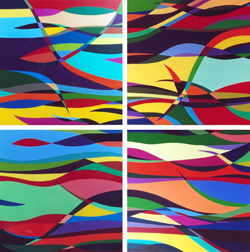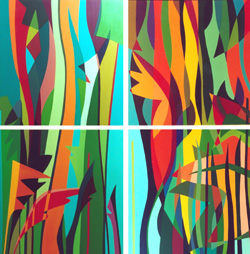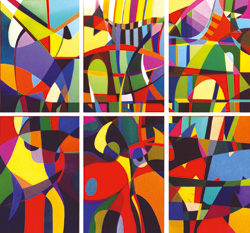I invite you to discover the world of meanings, concepts and history of each work.
Do you like artworks? Purchase your replica in sheet format.
INDEX
Back to back! In the Serengeti, buffaloes work as a team to defend each other from predators. The great migration of these majestic animals is one of Nature’s most incredible spectacles, challenging the limits of survival every year.
The Serengeti is a vast plain located in Tanzania, East Africa, known for hosting an incredible diversity of wildlife and for being the stage of the annual great migration of animals, including African Cape buffaloes.
African Cape buffaloes, also known as black buffaloes or “Cape” buffaloes, are large herbivorous mammals with an unpredictable temperament that makes them powerful in defense. Their gregarious nature leads them to form herds ranging from a few individuals to thousands in the vast savannas of the continent.
In these herds, males protect the edges while females and calves shelter in the center, minimizing risks during their journey. Old males lead and alert the group to potential dangers, such as lions, leopards, hyenas, and crocodiles.
In the face of a terrestrial attack, the strongest males line up like soldiers in battle, confronting the issue with determination and using their horns as weapons. After the confrontation, they regroup with great attitude and courage, demonstrating the strength and unity that characterize them.
The artist in this work captures the essence of buffaloes and states: “The animal behavior of perseverance, companionship, and herd is so immense that observing them gives me hope because children learn to share”…
Flamingos are an inspiring example for humans. These gregarious birds live in community and accompany each other throughout life, like true friends. From childhood, children learn from their teachers how to relate to others, share, and cultivate friendship.
It is crucial to recognize and promote this principle of companionship early on, as these are fundamental values that strengthen self-esteem and confidence at a young age. Like flamingos, children must learn to adapt to challenging environments, stand firm in adversity, and move forward with courage, tolerance, and perseverance towards concrete goals. Their grace and elegance in movement reflect the importance of dignity on the path to success.
Flamingos demonstrate their abilities in long migrations in search of food and favorable weather conditions. They invite us to reflect, to be open to change, and to leave behind old patterns and limiting beliefs. Through Gonzalo’s work, we see how coexistence in nature makes them an example of overcoming and transformation.
These majestic birds are symbols of love, balance, harmony, and spiritual connection. Their name, which means “flame or blaze,” was given to them by the Egyptians due to their fiery red color. In ancient Egyptian culture, flamingos were a representation of the god Ra, known as the sun god.
We invite you to explore and engage with children through Gonzalo Alvarez’s work: “The Dance of the Flamingos,” an opportunity to inspire creativity and connection with nature in the little ones.
Gonzalo Álvarez’s latest work resembles a peacock spreading its tail in a fan shape, radiating joy in awakening the dreams of others. The name “Anand” has Indian origins and means supreme joy and happiness, derived from the Sanskrit “Ananda.” Similar to the male peacock displaying its colorful plumage in a subtle dance to court females and protect itself from predators, the multiple eyes depicted in the artwork symbolize the connection with the eternal and vital cycle of Nature.
Gonzalo emphasizes the importance of love and resilience in every teacher, stressing that conscious self-change is essential to create new opportunities, especially for children. “Anand, the Prince of the Hundred Eyes” is the full name chosen by the artist to highlight the significance of a contemplative gaze towards students.
Anand embodies the power of benevolent love.
The natural biome of the Pampas region in Argentina is the grassland. Within this biome, the dominant vegetation type is the prairie, followed by the steppe. In this area, five subregions are distinguished: interior Pampas, southern Pampas, Mesopotamian, undulating, and floodable.
Gonzalo is interested in highlighting some species of the region’s wildlife in their natural habitat. “In the grassland, they all do the impossible to be free.” In the work, we can see the Pampas deer, the Southern screamer, the river otter, and the collared peccary.
“From the native flora, I painted the feather duster for its simplicity, elegance, resistance, and rusticity. Everything in nature is connected, that’s why learning from animals is wonderful.”
The Pampas region is an extensive plain, a geographical area located in the center of our country, and is the most productive area in Argentina. It has two mountain systems: Tandilia Mountains and Ventania Mountains. This region is composed of the provinces of Santa Fe, Entre Ríos, La Pampa, Córdoba, Buenos Aires, and the Autonomous City of Buenos Aires.
Conservation problems of natural fauna occur due to hunting and the loss of their natural habitat: the grassland. The artist expresses that this biome is being transformed, converted into crops and commercial forestation. All of this causes an imbalance and displacement of native species, which is why new education is very important.
KATU is the name of the new animal character in Gonzalo’s work, an intrepid ring-tailed coati freely roaming the forest. Its name means “strong” in Guarani language. These small carnivorous mammals inhabit the wooded areas of South America, such as the Chacoan Forest and the Missionary Forest in Argentina. Adult males are solitary, while females live in packs with their offspring. All have long snouts and strong claws that make them expert tree climbers.
“If we learn to love ourselves,” says the artist, “to speak about Nature, and to care for native species from a young age, we will see great results soon! The entire world will improve!”
The work invites us to learn about a particular species and then fill classrooms with environmental knowledge, colors, and artistic expressions.
Environmental artist Gonzalo Alvarez presents “The Jungle Magicians”, highlighting the importance of costume play in childhood. Inspired by the panther chameleon from Madagascar, which camouflages itself with the colors of nature, Alvarez aims to demonstrate how children dress up to create their own magical world.
The panther chameleon, also known as Furcifer pardalis, is the largest reptile of its species, reaching up to 55 centimeters in males and 35 centimeters in females. It inhabits the jungles of northeastern Madagascar, where it feeds on insects and utilizes its spectacular camouflage abilities to blend in with its surroundings. Its skin changes color by modifying the crystals in its cells and pigmentation, allowing it to mimic its environment.
According to Alvarez, allowing children the freedom to express themselves and choose their own costumes is crucial for their development. Just like the panther chameleon, children find security and confidence in their costumes as they play and explore their imagination. Alvarez also emphasizes that this work strengthens children’s innocence and promotes respect for their creativity.
For the artist, it is essential for adults, families, and educators to understand the importance of respecting children’s creativity and imagination, allowing them to play and dress up, as it contributes to their overall growth and emotional intelligence.
In “The Jungle Magicians”, the artist aims to convey the message that children should have the freedom to play and express themselves through costumes, just as the panther chameleon camouflages itself in nature. Alvarez urges educators to embrace the innocence of children and support them in their growth, respecting their creative world and innocence.
Nepal is the name of the new character created by Gonzalo Alvarez, an adorable red panda who watches us from a mountain forest. Born on the eve of the Year of the Dragon, which according to the Chinese calendar begins on February 10, 2024. Nepal inherits the strength, purity, sensitivity, and energy of this powerful animal to change the world.
The gaze and colors of Nepal convey a profound message, inviting us to reflect on our actions and reconsider how we act. For the artist, this challenge is constant: to raise awareness about lesser-known species and promote conscious education through his art. The red panda is a shy, solitary species that is highly vulnerable due to habitat loss.
Native to the mountainous regions of the Himalayas, including Nepal, Bhutan, southern China, India, and Myanmar, the red panda primarily inhabits moist temperate forests in high-altitude areas. Its diet is mainly based on bamboo, although it also feeds on fruits, roots, and eggs.
Children, through their teachers, enjoy and instantly connect with Gonzalo Alvarez’s work, experiencing profound changes in their habits and emotions.
ECOSISTEMA is a triptych theatrical piece that reflects the interaction between different species of animals from around the world. These animals gather in a forest to directly observe humans and convey a message about the importance of caring for ecosystems.
The ECOSISTEMA play showcases a variety of species, such as the red fox, wildebeest, kingfisher, polar bear, African wild dog, Komodo dragon, European deer, Sumatran tiger, and American stork. These animals silently observe us, inviting us to reflect on our behavior towards nature.
Through these silent gazes, the artist aims to raise awareness about the importance of protecting species and the environment. Feelings of compassion, temperance, joy, tenderness, and anger are manifested in these gazes. Gonzalo, the creator of these characters, seeks to capture the attention of those on the other side, urging us to question whether we are truly taking care of our natural surroundings.
MANDRILO is the name of the character created by the artist in a very cool new work of art.
Like many of the characters that the artist proposes with his works, this curious mandrill also focuses on the heart of a deep forest with a very calm posture.
His noble and serene gaze invites us to dialogue!
Gonzalo says: “It is very important that all children from their early education learn to share, respect their differences and listen to each other. But for that to happen completely, each teacher must be trained. Being emotionally prepared to lead as a pack leader is essential. MANDRILO and UBUNTU are works
related to the same look. “I am because you are.” This practice of circular education must of course also be sustained over time and at all levels, both in primary and secondary schools…”
These animals are very sociable and can form groups of up to 250 individuals. Within these large groups, subgroups usually form made up of around twenty baboons, most of them female and young with a dominant male.
On this occasion, the artist gives prominence to an OKAPI from the Congo Jungle. This jungle is located in the heart of Africa in a state of conservation due to the constant problems of deforestation and poaching that occur there.
“Life without friendship is nothing. It is a sharing and animals teach us that. Friendship is like a tree that grows and develops. If we all observe more and teach to share, another story will be.”
The Okapi, known as the “giraffe of the forest” is elusive and solitary. Its fur is chocolate brown which allows it to adapt and hide in vegetation. It also has zebra stripes on its legs and hindquarters.
The okapi is currently considered a vulnerable species on the long list of endangered species and that is why the artist manifests himself with his sensitivity and colors to make us all reflect…
This work for the artist has a very special meaning because it connects him directly with the emotion of a child. The work is born from a special bond with a child who captivated him by his demonstration of affection as he was waiting for him in the kinder garden to make art with his classmates. When that boy saw him, he hugged him and showed him his miniature dinosaurs that he carried with him. In that exchange the boy asked him: “When are you going to make dinosaurs?”
That same afternoon Gonzalo promised him that he would start sketching dinosaurs immediately, so he began to create possible scenarios, to study them…
“They invite me to be part of their world. Living up to them has its advantages. Boys love to play with dinosaurs. With them they acquire an understanding of the world and thus develop their cognitive abilities. At this stage of their lives they are playing, elucidating and delimiting the border between what is real and what is imaginary. My job as an artist is to always accompany them.”
Millions of years ago the dinosaurs were the great rulers of the world and everything was natural. They were later classified into two large taxonomic groups based on their hip structure. The lizard-hipped dinosaurs or saurischians and the bird-hipped dinosaurs or ornithischians.
Five species are observed in the work:
– A TYRANNOSAURUS REX
– A TRICERATOPS
– A PARASAUROLOPHUS
– A VELOCIRAPTOR
– A UNENGALIA COMAHUENSIS
The latter lived in Argentina, more precisely in the province of Neuquén.
The pangolin today is the most trafficked insectivorous mammal in the world. It is on the podium of critically endangered species. In both continents where it lives, it is persecuted for its exotic meat and its scales. Something very illogical to think and reason why the artist stopped to manifest himself accordingly…
With this work, Gonzalo proposes a great cultural change.
The work THE PANGOLIN is a key to the new consciousness. Through it, the artist seeks to honor childhoods and a defenseless species that still inhabits the planet.
The contemplation of this little animal becomes visible through the expression in its gaze and its colors.
“The pangolin is at risk of becoming extinct from this world before most people get to know it. This is my pangolin and it is a harlequin, it was born to transform the way we connect with the species…”
The harlequin throughout history was a resource and object of study…
The harlequin was a very popular character in the commedia dell’arte, a theatrical modality that emerged in Italy in the mid-16th century with striking clothing and whose purpose was to perform tricks, be showy, do things out of place and not so conventional. keeping the audience disengaged and happy.
In 1888-90 Paul Cézanne painted “The Harlequin”, in 1901 Pablo Picasso made “The Thoughtful Harlequin” and in 1919 Juan Gris immortalized “The Harlequin with guitar”.
Emilio Pettoruti in 1925 also made a series of works with this theme, after being with the futurists and cubists in Europe, he returns to Argentina and is one of those who “bring modernity” to Buenos Aires.
These artists are just a few who have made some of the most famous performances. The theme has been widely exploited by artistic research between the 19th and 20th centuries.
Today in the 21st century it takes shape again…
The character of the work is a puma inside the forest. Observing his serene look invites us to reflect.
What does NEO wake us up with his look?
Gonzalo affirms: “We must be able to denature and cut with the affective lack in our work space if we are or want to be a benchmark of quality. When I refer to these issues I also include the relationship between teaching peers, with families and with our students.”
“If we want a better future, we have to act and wake up right now in our present. Apply a quality circular education where dialogue exists and leads to the sharing of ideas and projects…”
Undoubtedly, the artist invites us to rethink our practices in detail… It is essential to have a healthy link reference from the emotional.
NEO which in Greek means new, “the new”
The puma lives in America and is the fourth largest cat on the planet after the tiger, the lion and the jaguar. In North America it is officially considered extinct due to human neglect of course.
The main threats facing the puma in Argentina are the loss and fragmentation of its habitat, the reduction of its natural prey, and poaching.
They are slender, agile and solitary…
“Pollution in the world’s oceans is a very negative constant for the lives of millions of marine species”.
“Understanding in its entirety the problems that the human being generates and managing to reverse them is a fundamental step to mitigate the consequences. That is why I believe that education should be the protagonist and get more involved in these issues.”
“What we know today is that marine migratory species travel great distances to survive and thousands of others inhabit the beaches. Man overfishes, generates plastic waste and tons of garbage that alter food chains everywhere. All this leads to the loss of marine ecosystems. In turn, the oceans, in addition to regulating the climate and feeding us, produce most of the oxygen we breathe” Gonzalo tells us.
The work opens a debate to exchange opinions between teachers and students in the classroom. The octopus Chichón appears in the scene chatting with his friends:
What do these characters reflect in their looks?
What are they talking about?
Why is the hammerhead shark so angry?
Why does the octopus seem somewhat disappointed?
How much longer can that manta ray resist pollution?
Surely from the observation new questions and many possible solutions will arise.
IL BOSCO is a triptych work of art that shows the magic of the pronounced forest.
“We need to talk about ecosystems before it’s too late…” says Gonzalo.
This work symbolizes the balance, serenity and peace of a powerful forest, affirming that a better world is possible if we all act in harmony. The fresh color palette and the images of species typical of a natural habitat as Gonzalo has accustomed us to, lead us in search of the pure state of consciousness.
The characters observe us and encourage us to think: “Innocence is recovered from the reunion with our own inner being. That inner being is there waiting for us to rediscover it and we can start over…”
“The pure state is in us. The trees in a forest speak to each other constantly, communicating above and below ground using sounds, scents, signals and vibrations. Forests symbolize the cycle of life, they embrace and contain species that we must learn to love” the artist tells us.
It is up to us to continue it!
The artist’s goal with this triptych work is to capture the full attention of the viewer. To do this, he uses the resource of looks. If we look at the entire work, the Ocelot is the only animal that looks us straight in the eye, inviting us to interact.
In pictorial times such as the Baroque or the Renaissance, one of the artists’ customs was for them to take self-portraits within a large painting, to reaffirm their authorship or to make their intentions understood.
Gonzalo also plays with it, he has transformed into this beautiful animal. His environmental intentions to take care of the forest are very clear and mark an important challenge of conscience in society.
The ocelot here is accompanied by the burg, a territorial, calm and solitary tropical bird with extreme beauty. It is native to South America.
In this module there is a toucan and an opossum. The characters in the scene begin to dialogue with each other.
The artist plastically shows us that the variety of these tropical birds is very wide and beautiful since it houses six genera and some forty-two species of toucans…
“Commonly we are familiar with only one species, so I wanted to reflect it in the work”
ROME is called the fawn. In general, children participate a lot in the works and are able to nickname the characters. In this case, 5-year-old Felicitas, chatting with her mother, chose this beautiful name.
Deer symbolize grace or the power of gratitude, innocence, intuition, speed and sweetness. Catching a glimpse of one symbolizes speed, stamina, leadership, and regeneration, while fawns represent innocence and the purity of youth.
Sometimes as adults we lose touch with our inner child, and seeing a deer can help us reconnect with that part of ourselves. They remind us to be kind to ourselves and to others.
ROME is accompanied by a friendly Red-faced Calancate, which is a South American bird of the parrot family. It is native to the Yungas in Argentina, it feeds on seeds and fruits…
The name of Libertido was born from a pedagogical meeting between initial level teachers in a seminar on art and awareness for the initial world. The name arose as a proposal from the teachers for the artist to design a new character and thus a new work of art emerges.
Thus, it was how the artist began to sketch and think of someone who is “free and fun” (libre y divertido) that would arrive to the classroom in a simple way. Gonzalo chose the rhea, because it is a native and ancestral species of South America.
“The rhea is the largest bird on the south american continent. This was hunted by man from the beginning. That is why it is so important, in current education, to use art as a means to talk about awareness, history, geography and ancient customs. Achieving the valuation of all animal species is essential for a paradigm shift, because there is a lot of inequality and we must be able to reverse it as soon as possible.”
“Education, at all levels, needs very profound changes in terms of forms of communication, in values and in curricular content. It is very important to me that adults and peers in schools respect each other. In the classrooms, emotional education is very necessary” affirms Gonzalo.
Every artist creates his works of art from concerns, needs and emotions. Gonzalo does not escape this rule. His recent work has a very successful and punctual pedagogical intention. The SOUTHERN RIGHT WHALE is a National Natural Monument of Argentina and expressing it in art will make it even more known.
The beaches and seas of the Valdés peninsula are a meeting place for this wonderful species. Said beaches today are contaminated by 80% of fishing garbage, plastics and other waste.
Thousands of other species that live there, such as the Magellanic penguins, numerous birds, killer whales, sea lions and elephant seals, suffer many problems daily due to the common cause of “pollution”, a fundamental reason that motivates the artist to continue manifesting.
“Transforming education, instilling respect and commitment is fundamental. All the seas and oceans of the planet suffer from the same problems! You have to wake up. We also have to understand that thousands of marine species have no other place to live.” This is what the artist says.
And that’s how Rocko was born! The sketches were embossed on the fabric to give it color. Rocko is an optimistic calf who wants to quickly reach the classrooms and the hearts of the children in order to raise awareness:
“The children are the first to always accompany me, they are receptive to understanding environmental problems and thinking of solutions. You have to know how to listen to them, that’s what circular pedagogy is all about. They are the future that is coming and it is for them that as adults we must assume our responsibilities. The best way to educate is by example.
In a 5-year-old room of a kindergarten with the help of their teacher, Virginia, the children chose the name of the character. Rocko was the name finally selected by them to give him an identity, learn in class and draw.
Welcome Rocko!
“Insects are the smallest and most diverse animals on earth, they are all essential for the balance and development of ecosystems, they contribute to pollination and collaborate with the reproduction of plants” This is what the artist states and proposes.
The green and white palette that Gonzalo uses in this work generate freshness and peace. “We work for hope, that’s why the work has these colors to awaken innocence, magic and strength in children, since through the color green one grows and feels that it is possible to sow.”
The looks of each one of the characters invite us to think about the mission of each one of them and when observing them there is a back and forth questioning. What do we do for planet earth? Are we aware of our daily habits? Situation of introspection that the artist has already accustomed us to.
“INSECTS are fully involved in childhood. For children everything is curiosity, play and wonder, that is why it is very important to learn from Nature and be a bridge to strengthen emotions in others.”
“INSECTS are a great example for us humans. We can learn from them companionship, collaborative and silent work, merit, effort, perseverance, joy and freedom just by observing
them.”
This work of art inspires to know the botanical world and introduce it in the classroom. Gonzalo offers us the opportunity to learn about tree species and awaken curiosity and imagination in children and adolescents.
The Ceiba is a tropical and subtropical forest tree in South America. In Argentina they are also seen in large cities and squares, but they naturally inhabit the yungas jungle and the Paraná jungle.
For the Mayans, the ceiba was responsible for sustaining the universe and was called Yaxché; which in the Mayan language means “green tree”. This tree was thought of as the bridge that connects the earth with the sky and the underworld.
Today it is still revered and sacred for various pre-Hispanic cultures. For them it means: life, perpetuity, greatness, goodness, strength and union.
One of the characteristics of the species that the artist highlights is that it retains too much water to satisfy its needs in times of drought and, if necessary, shares it with other species. “This is the magic of a forest, all the trees communicate in silence, they are in solidarity with each other, they share, they empower each other, they support each other and they embrace each other through their roots.”
“The human being often tends to create obstacles instead of bridges, to immerse himself in the individual and to draw selfish barriers instead of attenuating the path of others. Especially in education, it is essential to rethink the way we communicate. If necessary, the structure must
be completely abandoned, it must be started again. It is so important to KNOW HOW TO SAY NO and learn to stop.
The opportunity for change is at our feet…”
This is what the artist feels. His new work is suggestive even with the title. It is a very vertical work to challenge us once again and determine a position in the face of the indifference of egocentrism.
The work is composed of two equal modules. Black is the predominant color, which takes center stage and stands out to install the perplexity of the darkness of the human being and thus install a new debate: Are we honest with ourselves and do we act from the heart?
His disagreement with the referential bad manners is very clear and is decidedly seen in the look of the ankole. “The lack of respect in schools also generates violence and translates into more children feeling unhappy and hopeless…”
KNOW HOW TO SAY NO is an opportunity to transcend, learn to stop, work with our disabilities and transform them, because otherwise the species will continue to become extinct and children will continue to grow up without quality references.
“CONCAGUA was born to open paths achieving changes in the way we express our emotions.” This is how the artist manifests it by creating an elephant with an important stage presence. A blue elephant that stomps knowing how to guide his herd…
Observing the behavior of a herd of elephants helps us understand coexistence since they have great empathy, a great sense of camaraderie and collaboration with each other.
Elephants also show a great protective instinct and the artist through his work helps us reflect on these issues, seeking to institute emotional education in the classroom. “For education to prosper, it is necessary to talk about emotions in all school settings and give it continuity in all areas.”
“Knowing how to listen to the child is key. Colors are colors, colors have no gender. Through them we can express ourselves freely, CONCAGUA comes to express all that to us” affirms the artist…
FOX is one of the most optimistic works that the artist proposes to transform education and thus humanity. He raises altruistic love and kind love in the classroom: And as long as we can de able to express our emotions and feelings in time, we adults can happily achieve what we want. Kind love is a conscious desire for another’s happiness.”
This work was designed and developed very quickly, its importance is to make the Patagonian fox known in its habitat.
His expression is very solid. It is simple and clear to be able to connect the emotions with the observer. Emotions that adults hide; emotions that children arouse. Emotions that children need from adults to feel loved and respected.
FOX, in turn, represents all species and subspecies on the planet because there are foxes on all continents: “It is necessary to change history. But in order to change history, it is first necessary to accept it.”
This work was also shaped by real emotions. A group of children and their kindergarten teacher virtually met the artist. Exchanging emotions with them was fantastic and it inspired him from the beginning to create these colors.
During the 2021 school year, the world of this classroom was called Chipilandia, from those encounters the full name of the work emerged.
Chipilandia turned out to be a magical and joyful place where everything was possible, there they learned playing with great affection. Through art and their teacher´s help, the children assimilated nature contents and particularly about this species The opossums were nicknamed: Limbi, Lori and Pope Changuito.
In Chipilandia, the children, together with their teacher Larissa, besides researching, drawing and painting, created a story:
“Limbi, who is the smallest opossum, sees everything, she is the one who always pays attention to the details, the one who always shares the secrets that should not be kept.
Lori is the middle one and is always willing to listen. Together they combine their actions working as a team. The rule is that no one is left out and that everything becomes a form of coexistence…”
As the story goes:
“Pope Changuito” is the oldest of the three. She might be the strongest and shelters everyone in her spirit. She cares for and protects with her power called “Love”. She is encouraged by everything and just as they do in her species, she carries on her back those who do not have strength and those who are not yet ready to undertake the journey alone.
They say that these opossums came with all their love to save the world. Because the magic happened in Chipilandia….”
APU, is the name chosen for the spectacled bear that was born with a great desire to cuddle. “Ukumarí or Ucumari” is an indigenous word that the Emberas Chamí use to identify this native species of the Andean region, which nowadays is on the verge of extinction.
With his art, the artist proposes the emotional transformation in the classroom from the initial level to dialogue in another way. An image and a scene that invites us to become aware, to investigate and get to know the only bear species that lives in South America.
This magical animal lives in the Andes mountain range, from western of Venezuela to Argentina´s northern. The largest population lives in Peru, its claws stand out for being great tree climbers.
Its conservation status throughout the region is vulnerable, indifference and deforestation are its main problems.
Making it visible from education is a challenge and this work of art proposes it to us.
“THE KING”, was born to transform, to roar for them…
Roar to speak of love in many new ways. For children to be respected.
“Roar” is the name chosen for this lion. He was born to protect children and impart justice. With this work, the artist asks himself: Will the human being banish violence one day and forever? What credible legacy do we want to leave our children and our students if we do not modify our selfishness, our bad acts and do not learn to communicate with greater respect?
The lion is one of the most outstanding terrestrial felines and today, in turn, is the most vulnerable on the planet. With his gaze he invites us to reflect…
The king is on the extinction list. Will we do something to change our habits? Will we do something to save it?
It only depends on us.
This work immediately takes us to a jungle.
To know more about native and endemic species of Argentina mainly. Platyrrhines are New World arboreal primates that live in the tropical rain forests of America. They are all characterized by being able to live in community.
The artist expresses himself with excitement to protect them, make them known, enter into an environmental debate and thus strengthen the forests.
MONKEYS inhabit the provinces of Chaco, Misiones, Corrientes, Formosa, Tucumán, Jujuy and Salta. The main problems for these primates are: the large-scale fragmentation and deforestation of their habitats, illegal hunting and wildlife trafficking.
On the scene appears a group of red carayá monkeys, whose scientific name is alouatta guariba. The artist presents how they are in coexistence and the camaraderie that the species can demonstrate in the same space. They are known as carayá pitá, red carayá or reddish brown carayá; also as northern brown howler monkeys. They live in high jungles from southeastern Brazil to extreme northeastern Argentina. They are diurnal habits.
In this module we find the black or howler carayá and the caí bayo or caí of Yungas. Howler monkeys are named for their amazing roar. Despite being primates weighing just seven kilos, almost like a small dog, the sound they produce with their throats reaches a frequency similar to the one a tiger does, which makes them seem larger than they are, there are also golden ones. Caí monkeys are very curious and expressive, due to their charisma they are easy to catch and to be sold or enslaved.
Moose are a wonderful species, here is Fausto (Faust) with a subtle look to help us understand what compassion and natural respect for each other is.
Blue as a color of inspiration to balance energy in a spiritual dialogue. The artist tells us that within a herd, these mammals accept each other with familiarity and welcome a new member with joy. An example to highlight.
In turn, the Nordic forests have been flatly reduced over time and every forest is a transcendental natural heritage.
This work invites us to rethink our behaviors, to encourage us to feel what traces we want to leave.
The giraffe “PEPITO” is the unique character of this work. In a new awakening he was born to accompany the boys and teachers in the classrooms. He came to express the collective friendship of knowing how to share and renew the values of the word.
UBUNTU means: “I am because you are”, it is a message originating from the old African continent that brings us closer to reflect on today.
With this title and this work the artist expresses the language of circular communication. Knowing how to freely express what we feel is a simpler way to connect.
The NOA work immediately takes us to a geographical and ecological region of Argentina. Although their name refers to several provinces in northwestern Argentina, these endangered species wander absently, hunt each other, ignore each other, hide there in the woods and mountains of arid zones, also in several neighboring countries. This is a reality that the artist leads us to reflect on, since their natural habitats are violated, a reality without borders. The Andean cat nicknamed “IBBAR” by the author, is the most unprotected Latin American feline in America due to the indifference towards him. The taruca along with the ñacurutú accompany him, the three of them look at us and question us. The cactus as natural flora also appears prominently in the work; an American species of millions of years. Cactus benefit the atmosphere by absorbing carbon dioxide, acting silently at night.
This work invites us to imagine and reinterpret history after passing 500 years. To discover that flora of Patagonia that is still alive and unseen.
“The conquest” and the voyages of Magellan turned out to be the discovery of the southernmost and most bionatural passage in the world. That trip that began with five caravels and only one returned, left deep traces, it had the purpose of opening a commercial route with the spice islands.
Is that kind of conquest still the only purpose of man?
Without knowing the flora and its history, we will hardly be able to start over.
Two works of art united by the same passion make up a single piece to study in depth and reflect in detail
In this module you can see the simplicity, but at the same time the artist wanted to express the dispute of species. The exotic ones have invaded the territory of the natives. Carpobrotus edulis is an invasive exotic plant introduced by man that caused irreparable damage to ecosystems and continues to do so today. Native ones such as Canelo, Calafate and the Chilco flower reflect their magic, they are edible, medicinal and sacred.
Here the golden orchid appears as the protagonist, which is the oldest native flower in America, they are very sensitive plants that only grow in the purest forests. Then there are the Mutisias that were chosen by the artist for their wild and savage characteristics. The Calafate flower appears and after growing it bears fruit.
“Nénggòu” is the name chosen for the European lynx. It means “power” in Chinese, the power of action: the “I can”. His presence, gaze and colors express a lot. It is the way the artist uses to communicate the love for biodiversity and raise awareness of endangered species. Formerly lynxes freely inhabited forests and snowy mountains throughout Eurasia, today their habitats and spaces are very small.
It is a work that was created to strengthen education from Knowledge, what the birds themselves teach humanity. These birds inhabit Argentina and Latin America. The work also represents freedom in all its aspects, the ways they have of communicating. Several of them are unknown and through art is a way to do it. How are we? Are we free?
This new work invites you to discover a natural forest from the inside. The artist describes it in colors and shapes after having been in person touring it, also walking through a volcano in southern Chile. The forests of the Patagonian region are unique, he affirms, but even the National Parks are not valued as they should be. In the feeling of him embodied in art, the artist confesses that the human being must learn to familiarize himself and communicate even more with nature, in order to understand each other. Here the very curious small native birds “Chucaos” are shown in society.
The year begins and the artist surprises us with an extraordinary new work in triptych. A complete work that challenges, that invites you to reflect on. The strong presence of these great animal beings makes us think about how we act. The Asian continent is the largest and most populated in the world. How do we live? Are we aware of our actions? Are we capable of changing our habits?
Momo: It is the name of the panda bear that Gonzalo chose to show us his happiness. He also reflects the result of science and represents the conscious change of man and what he did to order and restore his behavior by changing his bad habits. Today the panda is no longer extinct.
Smart Calixto: It is the imaginary name of the bengal tiger that Gonzalo creatively created and baptized to chat with the boys. Tigers and subspecies no longer have space, they are diminished by poaching and the constant depredation of their habitat. It is very necessary to change course. In the center of the scene he confronts us.
Sudan:It is the deceased rhino that could never be free. The subspecies has already become extinct, time is short and there is no turning back. In both Asia and Africa, rhinos are at constant risk. The artist, in his intention to excuse the mistreatment that the poor animal has suffered due to actions and omissions of the selfish man, has imaginatively portrayed him in his childhood “long before the shipwreck” as he says. Will we change humans as a species? Will we correct the course?
The work is an immediate response to deforestation in ecosystems. After knowing the realities of indigenous families in the province of Chaco. The artist expressed himself by devising a fantastic work. They would be varieties of giant carnivorous plants at the entrance to a forest. Plants that would feed on human beings, evil, ruthless and soulless. These giants would protect the other species from predatory man in each habitat. If that happened, another would be the reality. His proposal invites us to reflect on bad practices and human behavior.
The work allows us to know a particular story of an ocelot cub called “Pardus” who became orphaned and one day will be free again in the Misiones jungle. A sensitive and native species of the Paraná region in danger of extinction.
This work synthesizes the strength of trust. The artist connects the innocence of these not so well known species from another continent. The expressions of these animals show the example of coexistence and invite healthy reflection. They are unique species on the planet that are in danger of extinction.
The work “Marina”, the giant tortoise that from that solemnity looks at us and makes us think. Why is the man in his direct actions with hyperconsumption so harmful and selfish? The damage caused directly due to plastic to all species in the seas and oceans is unbearable. A turtle questions us and leads us to reflect.
With this combination of color and soft shapes that are integrated into the work, the artist expresses the spirituality and freedom of these wonderful birds. The work is an encounter and a search for that spiritual path of what we are and what we want to become. Unique hummingbirds of America. Stories and legends of native peoples.
For the artist, the Iberá work marks a new language of communication in the non-word and proposes a new challenge. He freely uses color to express himself and make known the native Argentine fauna in a new national park. In particular, the alligator is painted in many colors. In this way he shows a new reference stimulating the free creativity of the other. In education, it often happens that teachers limit their students,whom cannot express themselves in peace. “Colors are colors, and we are free to express ourselves,” he says.
The work finds the purity, the simplicity and the synthesis of a native forest with its species in coexistence and in its maximum expression. The piece of art is a call to introspection, it is a message to the conscience of man. The artist wishes to communicate in this way that it is very important to know that only 6% of this forest exists in the region and that is why we must conserve it.
This work was chosen by authorities to represent our country in environmental forums to the FAO. The work identifies these exotic species of fauna and flora that are harmful to our environment and shows the damage they cause. The artist tells us how they displace the local ones causing irreparable damage. Today these species affect the economy, culture and biodiversity in Argentina. The most feared is the beaver, from Canada.
Here color is key to show the freshness and importance of freshwater ecosystems, essential for health and our lives. Wetlands are great transformers of oxygen. The work shows the native flora “el irupé” or victoria cruziana.
It is a very significant work, since from a more distinct figuration in his abstract style the artist can express his environmental knowledge. This work is linked to the subsistence of the most beautiful Latin American feline. The Yaguareté, also called jaguar, panthera onca or better known as the Creole tiger of Argentina. The feline has been declared a national monument (Law 25.463) and there are only about 250 of them left in three different regions of our national territory: Misiones jungle, Chaco forest and Yungas. The artist says that its habitat has been considerably reduced in recent years and this work is a call to conserve it. In this same sense, an Art and Literature CONTEST has been devised: “JAGUARETES IN THE YUNGAS” stories of children with adventure…
“El Brote” (The Bud) is a detachment that is born precisely from a parallel work called “Yungas”. The artist often plays and is reflected in the work. Sometimes it is a crazy microbe, a colorful alligator and other times a meek manned guazú. In this case it is an outbreak, you see it with open arms happily communicating.
Not cutting the natural connections was the artist’s challenge in this work. The Quechua name Yunga means “Warm Valley”, they are also recognized as “Mountain Forests” or “cloud forests”. They are a tropical jungle celebration that unites several Latin American countries from Venezuela to Northern Argentina through the Andes. Charged with energy, the artist uses his color palette to describe her. It is one of the regions typical of the jaguar and that is why it is very important to avoid the indiscriminate felling of native trees since in addition to deforestation, which brings floods as an immediate consequence, all the species that live there lose their territory.
The color palette used by the artist in this work is a way of questioning the poorly achieved deforestation by man in native forests and the abuse of land use by agriculture that ends in desertification and ecological degradation at a global level. The strategy in the use of color is very intelligent and is key to bringing these complex issues into consideration anywhere in the world. Are we capable of understanding the degree of selfishness of the human being that preys on everything? The title of the work is also very suggestive since it is not linked to chance in the artistic approach.
The artist in this work expresses with great strength, determination and color his vision of life. His intention also aims to reflect and rethink the reason for the humanitarian crises, social injustice and inequality in the current continent.
Poverty, desertification, poaching, climate change and its constant disadvantages with the other continents.
That is why the artist chose an animal native to Africa, to make us think about how we act globally. He puts it on stage in the first person to observe us. As if she silently knew of our actions. Do we really evolve or regress as a species? How do we act today? The gaze of a zebra with innocence and uncertainty in the face of an increasingly selfish, more banal and more indifferent society. Pangea, the prehistoric man in contrast with the current man. Reason and emotion. Life against the danger of predators.
In April 2020, this particular zebra traveled the internet until it reached a rural school in Kenya where a beautiful group of children with her referent met her and began to work with other artworks made by the artist. Love is a very powerful feeling. They named the zebra Manolo! So from now on Manolo neighs much happier than before, to truly accompany them, because theirs, only theirs is the world to come…
In this work, the artist manifests his rebelliousness and his wild side, in a very deep cry against forest exploitation and the threat of fires caused. It’s colors and the abstract geometric shapes represent birds, plants and snakes. The importance of truly caring for the great lung of the world. Amazonia or Amazonía as it is still recognized today is a vast region of the central and northern part of South America that comprises the tropical forest of the Amazon basin. Outstanding and worthy of admiration for raising awareness of what we breathe and for being the eco-region with the greatest biodiversity in the world.
The artist marks with this color palette an intense challenge against climate change and global warming. His travels and his tour of the Los Glaciares National Park, located in the southwest of the province of Santa Cruz in the Austral Patagonian Region, had its results. His return has been to recreate that freshness, that strength and that characteristic peace. The turquoise and blue colors of it are those that arise from the depths of that great frozen mass. Environmental Education towards awareness of good responsible use of energy is his goal. It is essential to talk about these issues in order to preserve these continental areas and glaciers, which are in particular the largest territory of the National System of Protected Areas.
Here are the microorganisms reviled by the social imaginary, but essential in the functioning of the ecosystem. Through an invitation to play and in turn to discover the importance of these beings imperceptible to the naked eye. The work seeks to inspire in the youngest a healthy rebellion to defend nature. In the painting, each one appears with different characteristics and expressions, representing the richness of diversity. Invisible and tiny, microbes are everywhere and represent the oldest form of life. Some play essential roles, for example, in digestion, the breakdown of garbage or the growth of plants, while others are harmful, known as germs or viruses. One of the premises of this work is to find the vital balance of hygiene and the need to connect healthily with nature, the other one is to accept ourselves as we are, with our emotions and without stigmatizing.
The work manifests the origin of a Forest, it is a call to the environmental conscience of the planet to save all the original forests. The only green color palette represents hope, posing an authentic look of respect and appreciation towards the future of forests and plants. It is a call to introspection and dialogue. “Kalimantan was the name by which the original peoples of the island of Borneo acclaimed their valued forest, the same that was deforested almost entirely in the 1980s and 1990s, being one of the most unfavorable actions made by man in the world” the artist tells us. Today Borneo is divided into Indonesia, Brunei and Malaysia. Today Kalimantan rises again as a faithful example of constancy and perseverance to move forward.
The pure abstraction of the work questions the observer. Are we capable of understanding the universe, the origin of things and the nucleus? Millions of microparticles make up the whole. We are part of a whole and we are intimately connected. Are we connected with our emotions?
As its name indicates, the work is a determined and firm position. Today, society consumes too many things that it does not really need, generating bad consumption practices that leads to environmental pollution. Waste, garbage, poaching, deforestation are recurring themes that the artist uses to make us think. Three native species from different regions and united among themselves for the same cause: the condor, the anteater and the armadillo carreta. Today in danger of extinction, they manifest such disagreement with their looks and their presence.
The Tiger and the Dragon represents the balance of Yin and Yang, it is one of the most fantastic, intense and abstract works of the BIO Project. Gonzalo Álvarez wanted to propose a new communicational slogan: “the power to stop before the silence to observe”. Based on his oriental knowledge of the Pa-Kua, the work expresses internal balance, patience and temperance. “Be patient” as traditional Chinese philosophy puts it. The work specifies a principle of constant learning and resilience.
This work develops the importance of protecting the tropical and subtropical forests of the planet. They are the habitats and natural environments of millions of birds. The artist tells us that there are about 10,000 wonderful species on the entire planet. Some 3,500 live in Latin America and our country has an enormous diversity that reaches 1,000 species, thus leading to 10% worldwide. We also have some 16 exclusive species in our territory, such as the Macá Tobiano. Unfortunately, more than 100 of these native and wild species are also in danger of extinction.
The work is so called to understand native species in Argentina. In particular, the work involves the Tarucas, also known as northern Andean deer, the Swamp Deer, and the Huemules in southern Patagonia. This scene represents the causality of a family displaced by the malicious fire that threatens them. What if this happened to us? Forest fires are a reality and cause irreparable damage to natural habitats. Environmental Education is a fundamental tool that must be pronounced from the school to reflect on time and be much more responsible. Know how to behave when we are in a national park or in any natural protected area. Their faces subtly reflect their uncertainty in the face of danger. It is a work that also invites us to think.
Water here was represented by what it is: “source of life”. An indispensable element of Nature. The work is born from a trip and has had nine months of work for its creation. The artist has poured his effort, his commitment and his concern. He always says that on one of his trips to northern Argentina, Salta and Jujuy more precisely, he encountered so much lack, so much injustice and that is why he decided to express himself in this way. His work is a message of more awareness, of compassion for those who have less. That is why he raises empathy with the other. Fresh water, pure colors reflected there, to prevent waste from happening.
What is a Jungle? For Gonzalo, the native forests have a great value and a great meaning: “freedom”. The work is an extract from the missionary jungle. His work manifests the natural power of plants in the plant kingdom. His message contains a fundamental value to continue communicating in his art workshops the importance of conserving and knowing what it is a national park and what are the natural protected areas. The objective is raising awareness among others and taking care of their biodiversity among all.
It is the transcendental art piece of the Projecto BIO. From her came the idea of starting to create awareness through art and make it a reality. Over time, the artist began to materialize with his work that dream in environmental and unpublished works of art. With colors and shapes, inspired by mother nature herself. Animal Kingdom: Animals gathered to protect themselves, all of them mixed in a palette full of life. Today, creating bridges of inspiration and trust in children through education and the word has transformed his lifestyle.
I want my replica
- Size: 32 x 47.5 cm
- Photographic paper
To acquire your replicas in sheet format, you can request them by clicking the Whatsapp button, by mail to [email protected] or by completing the following form:

